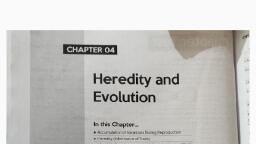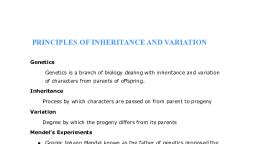Page 1 :
. Heredity:, The process of passing traits from parent to offspring is called heredity. Trait is any, characteristic that is transferred from parent to offspring. e.g. height and colour., inherited traits., In humans, eye color is an example of an inherited characteristic: an individual might inherit, the brown-eye trait from one of the parents. Inherited traits are controlled by genes and the, complete set of genes within an organism's genome is called its genotype, Rules for the Inheritance of traits- Mendel’s contributions:, Gregor Johann Mendel was a pioneer among geneticists who put forward the concept of, inheritance of characteristics or traits from parent to offspring. Mendel proposed the principle, of inheritance and is known as the “Father of Genetics”. Mendel has chosen pea plants for his, experimentation and found variations among them. Gene is a structural and functional unit of, heredity and variations. Gene is a DNA segment on the chromosome. Genes control the, expression of characteristics. Mendel called the genes to be factors., Traits can be either dominant or recessive. Tallness in a plant is a dominant trait, controlled, by a dominant allele and is represented by “T” (capital). Shortness in a plant is a recessive, trait, controlled by a recessive allele and is represented by “t” (small)., • Homozygous is a condition in which a gene possesses a pair of the same alleles (TT or tt), for a single characteristic., • Heterozygous is a condition in which a gene possesses a pair of different alleles (Tt) for a, single characteristic., Phenotype is a morphological expression of a single character. For example, tallness or, shortness represents the phenotype of the plant. Genotype is the genetic make-up of a cell, an, organism, or an individual (i.e. the specific allele make-up of the individual), usually with reference to a specific characteristic under consideration. Alleles combine to make a, genotype, such as TT or Tt or tt., Punnett square is a statistical method that was used by Mendel to predict the possible, genotypes and phenotypes of the offspring., Monohybrid inheritance, It is the inheritance of a single characteristic controlled by different alleles of the same gene., • F1 generation is the first filial generation offspring produced by crossing two parental, strains. All the progeny of F1 generation were tall i.e. the traits of only one parent were, visible., • F2 generation is the second filial generation offspring produced by crossing F1’s. The F2, progeny were not all tall. Instead, one quarter of them was short indicating both the traits –, that of tallness and shortness were inherited in the F2 plants., • Genotypic ratio – 1:2:1, Phenotypic ratio – 3:1., Dihybrid inheritance, It is the simultaneous inheritance of two characters., • Dihybrid inheritance is the experimentation of two characteristics with their four, contrasting traits., • For instance, dihybrid inheritance involves a plant producing round and yellow seeds (RR, and YY) crossing with a plant producing wrinkled green seeds (rr and yy)., • F1 progeny produces round and yellow seeds (R and r, and Y and y) in which round and, yellow are dominant traits., • F2 progeny were similar to their parents and produced round yellow seeds, while some of, them produced wrinkled green seeds. However, some plants of the F2 progeny even, showed new combinations, like round-green seeds and wrinkled-yellow seeds., Thus the tall/ short trait and the round seed/wrinkled seed trait are independently inherited., How do these traits get expressed?, A section of DNA that provides information for one protein is called the gene for that protein., The proteins synthesized according to this information may be enzymes that catalyse, biochemical reactions. Each trait is the outcome of several such biochemical reactions each of, this is controlled by a specific enzyme., Each parent contributes one copy of the gene for a particular character. Thus there are two, genes for every character. In the gamete, however, only one copy is present because of, reduction division and these may be either maternal or paternal origin. When two germ cells, combine they will restore the normal number of gene copies in the progeny ensuring the, stability of the DNA of the species., Sex determination, It is a mechanism which determines the individual to be a male or a female based on the sex, chromosomes present in it. In human beings, sex is determined by genetic inheritance. Genes, inherited from the parents determine whether an offspring will be a boy or a girl. Gene for all, the characters are linearly arrange on the chromosomes. The chromosomes that carry genes, for sexual characters are called autosomes or sex chromosomes while those that carry genes, for the vegetative characters are called autosomes or non sex chromosomes., Women have XX chromosomes while men have XY., All the children will inherit an X chromosome from their mother regardless of whether they, are boys or girls. Thus the sex of the children will be determined by what they inherit from, their father.
























































